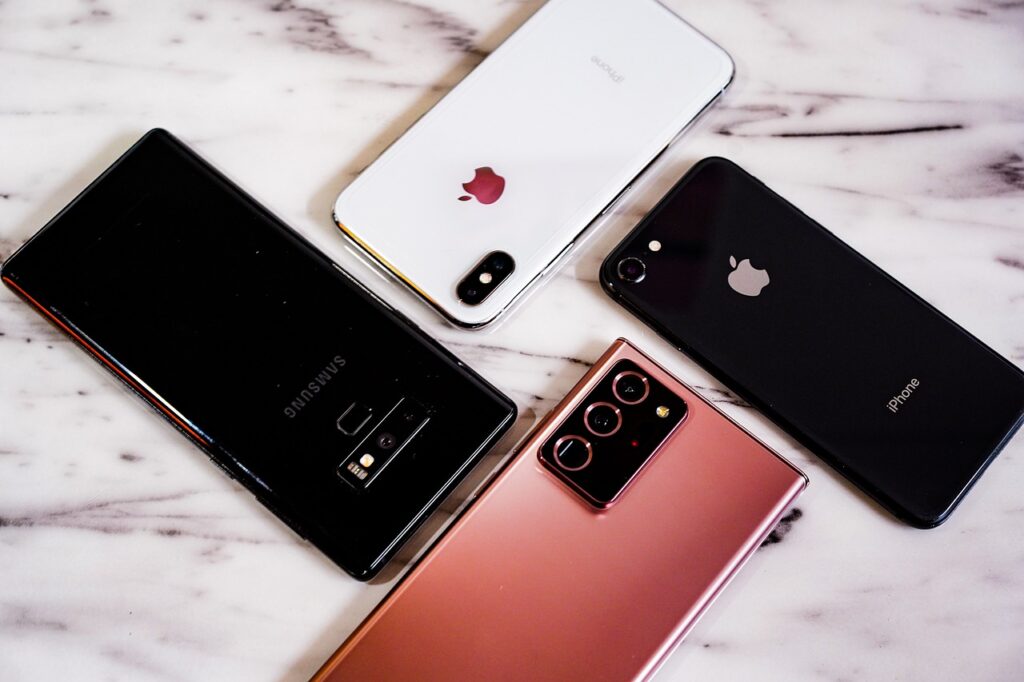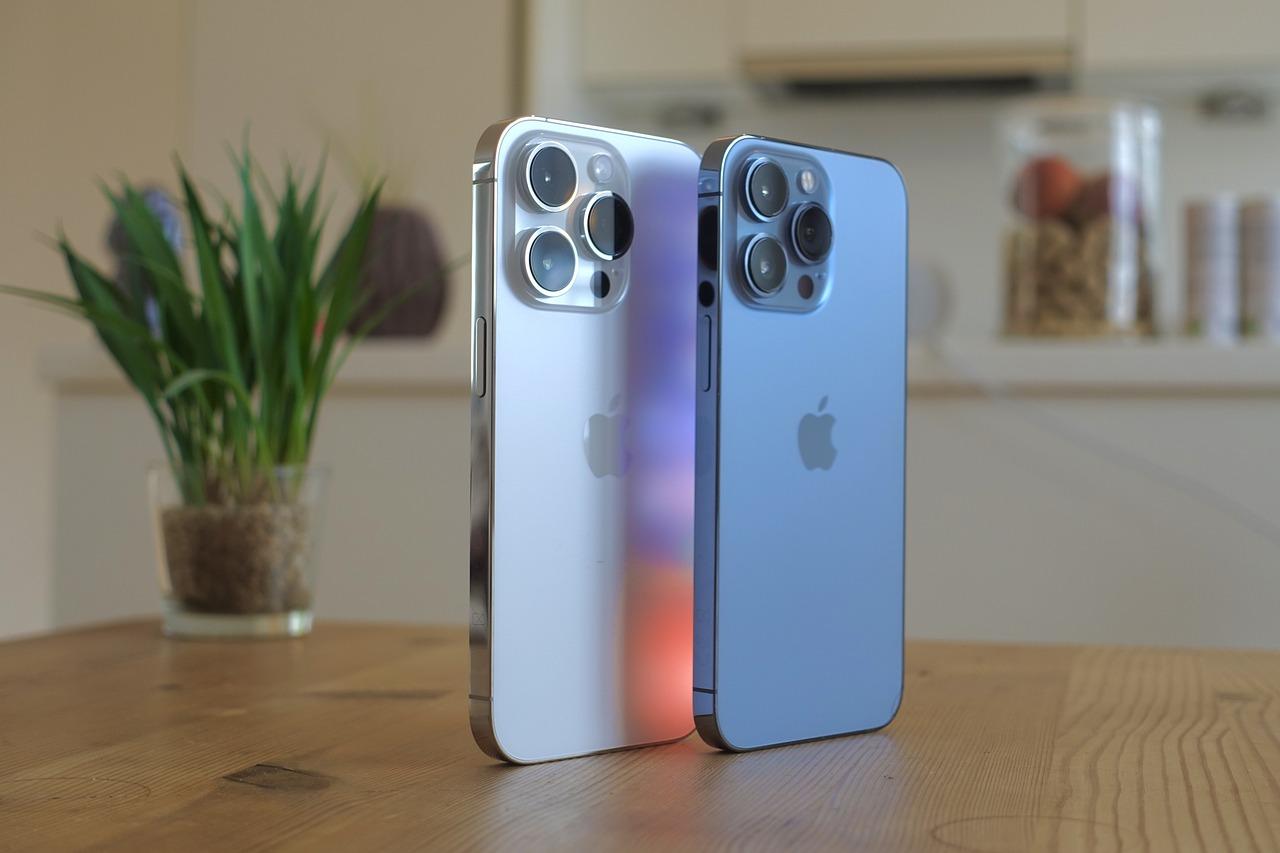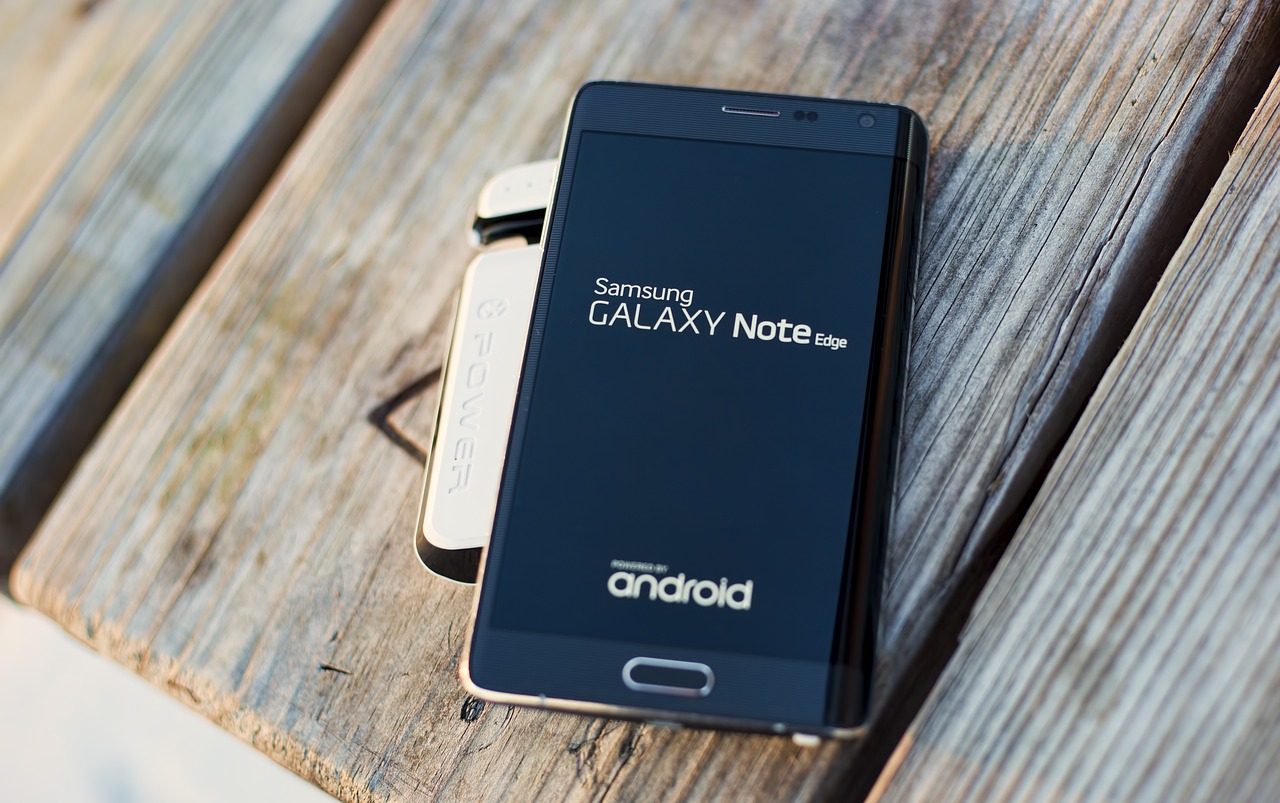Flagship Battle: Comparing the Latest iPhone and Samsung Galaxy Models

Design and Build Quality
The latest iPhone and Samsung Galaxy models showcase the pinnacle of smartphone design and build quality, each with its unique approach to aesthetics and durability.
iPhone Design
The newest iPhone continues Apple’s tradition of sleek, minimalist design. It features a premium glass and stainless steel construction, with flat edges reminiscent of earlier models. The device boasts a Ceramic Shield front cover, claimed to be tougher than any smartphone glass. The camera module is arranged in a distinctive square layout, adding visual interest to the otherwise clean rear panel.
Samsung Galaxy Design
Samsung’s latest Galaxy model embraces a more curved and ergonomic design. It utilizes a combination of Gorilla Glass Victus and aluminum for its construction, offering a balance of durability and lightweight feel. The camera module is integrated into the frame, creating a seamless look that flows from the side to the back of the device.
| Feature | iPhone | Samsung Galaxy |
|---|---|---|
| Materials | Glass, Stainless Steel | Glass, Aluminum |
| Dimensions | 146.7 x 71.5 x 7.65 mm | 151.7 x 71.2 x 7.9 mm |
| Weight | 204 g | 168 g |
| Color Options | Graphite, Gold, Silver, Sierra Blue | Phantom Black, Phantom White, Phantom Green, Phantom Pink |
Both devices are IP68 water and dust resistant, capable of withstanding submersion in up to 1.5 meters of water for 30 minutes. The iPhone’s flat edges may provide a more secure grip for some users, while the Galaxy’s curved design might feel more comfortable in hand.
Display
The display is a crucial component of any smartphone, and both the iPhone and Samsung Galaxy push the boundaries of screen technology.
iPhone Display
The iPhone features a Super Retina XDR OLED display with ProMotion technology. This allows for an adaptive refresh rate of up to 120Hz, providing smoother scrolling and more responsive touch input. The screen boasts a peak brightness of 1200 nits for HDR content, ensuring excellent visibility even in bright sunlight.
Samsung Galaxy Display
Samsung’s latest Galaxy model sports a Dynamic AMOLED 2X display with a 120Hz adaptive refresh rate. Known for its vibrant colors and deep blacks, the screen offers a peak brightness of 1500 nits. The Galaxy’s display also features an under-display fingerprint sensor, providing a seamless front design.
| Feature | iPhone | Samsung Galaxy |
|---|---|---|
| Display Type | Super Retina XDR OLED | Dynamic AMOLED 2X |
| Size | 6.1 inches | 6.4 inches |
| Resolution | 2532 x 1170 pixels | 3088 x 1440 pixels |
| Refresh Rate | 10-120Hz adaptive | 10-120Hz adaptive |
| Peak Brightness | 1200 nits | 1500 nits |
Both displays offer HDR10 and Dolby Vision support, ensuring a premium viewing experience for compatible content. The Galaxy’s slightly larger screen and higher resolution may appeal to users who prioritize screen real estate, while the iPhone’s display is known for its color accuracy and True Tone technology.
Performance

Performance is a key battleground for flagship smartphones, with both Apple and Samsung pushing the boundaries of mobile computing power.
iPhone Performance
The latest iPhone is powered by Apple’s A15 Bionic chip, a 5nm processor that boasts significant improvements in both CPU and GPU performance over its predecessor. This chip features a 6-core CPU (2 high-performance cores and 4 efficiency cores) and a 5-core GPU. The Neural Engine, capable of 15.8 trillion operations per second, enhances machine learning tasks and AI capabilities.
Samsung Galaxy Performance
Samsung’s Galaxy flagship runs on the Exynos 2200 (in some regions) or Qualcomm Snapdragon 8 Gen 1 (in others), both 4nm chips offering substantial performance upgrades. These processors feature an 8-core CPU configuration and advanced GPUs capable of ray tracing for improved gaming graphics.
| Feature | iPhone | Samsung Galaxy |
|---|---|---|
| Processor | A15 Bionic | Exynos 2200 / Snapdragon 8 Gen 1 |
| CPU Cores | 6 (2 high-performance, 4 efficiency) | 8 (1 prime, 3 performance, 4 efficiency) |
| RAM | 6GB | 8GB / 12GB |
| Storage Options | 128GB, 256GB, 512GB, 1TB | 128GB, 256GB, 512GB |
| Geekbench 5 Single-Core Score | ~1750 | ~1100 |
| Geekbench 5 Multi-Core Score | ~4800 | ~3500 |
While benchmark scores tend to favor the iPhone, real-world performance can vary based on optimization and use case. The Galaxy’s higher RAM options may provide an edge in multitasking for some users.
Camera
Camera technology continues to be a major focus for smartphone manufacturers, with both Apple and Samsung offering impressive imaging capabilities.
iPhone Camera
The latest iPhone features a triple-lens rear camera system:
- 12MP main camera (f/1.5 aperture)
- 12MP ultra-wide camera (f/1.8 aperture, 120-degree field of view)
- 12MP telephoto camera (3x optical zoom, f/2.8 aperture)
Key features include Night mode, Deep Fusion, and Apple ProRAW for advanced photo editing. The iPhone also offers Cinematic mode for video, allowing for professional-looking depth-of-field effects and focus transitions.
Samsung Galaxy Camera
The Samsung Galaxy boasts a versatile quad-camera setup:
- 108MP main camera (f/1.8 aperture)
- 12MP ultra-wide camera (f/2.2 aperture, 120-degree field of view)
- 10MP telephoto camera (3x optical zoom, f/2.4 aperture)
- 10MP periscope telephoto camera (10x optical zoom, f/4.9 aperture)
Samsung’s camera system features Space Zoom (up to 100x digital zoom), Director’s View for simultaneous front and rear camera recording, and advanced night mode capabilities.
| Feature | iPhone | Samsung Galaxy |
|---|---|---|
| Main Camera | 12MP, f/1.5 | 108MP, f/1.8 |
| Ultra-Wide Camera | 12MP, f/1.8, 120° FOV | 12MP, f/2.2, 120° FOV |
| Telephoto Camera | 12MP, 3x optical zoom, f/2.8 | 10MP, 3x optical zoom, f/2.4 |
| Additional Camera | – | 10MP, 10x optical zoom, f/4.9 |
| Video Recording | 4K at 60fps, HDR with Dolby Vision | 8K at 24fps, 4K at 60fps |
Both devices offer exceptional camera performance, with the iPhone generally praised for its consistent color science and the Galaxy for its versatility and zoom capabilities.
Battery Life

Battery life is a crucial factor for many smartphone users, and both Apple and Samsung have made significant strides in this area.
iPhone Battery
The latest iPhone features a 3095 mAh battery, which Apple claims can provide up to 19 hours of video playback. The device supports 15W MagSafe wireless charging and 7.5W Qi wireless charging. Fast charging capabilities allow the phone to charge up to 50% in about 30 minutes with a 20W adapter (sold separately).
Samsung Galaxy Battery
Samsung’s Galaxy model is equipped with a larger 4500 mAh battery, offering up to 20 hours of video playback. It supports 25W fast charging, 15W wireless charging, and 4.5W reverse wireless charging, allowing it to charge other Qi-compatible devices.
| Feature | iPhone | Samsung Galaxy |
|---|---|---|
| Battery Capacity | 3095 mAh | 4500 mAh |
| Wired Fast Charging | 20W | 25W |
| Wireless Charging | 15W MagSafe, 7.5W Qi | 15W Qi |
| Reverse Wireless Charging | No | Yes (4.5W) |
| Video Playback Time | Up to 19 hours | Up to 20 hours |
While the Galaxy boasts a larger battery capacity, real-world performance can vary based on usage patterns and software optimization. The iPhone’s integration of hardware and software often results in competitive battery life despite the smaller capacity.
Software and User Experience
The software ecosystem and user experience are significant differentiators between the iPhone and Samsung Galaxy models.
iPhone Software
The iPhone runs on iOS, Apple’s proprietary mobile operating system known for its:
- Smooth and intuitive user interface
- Tight integration with other Apple devices and services
- Regular and long-term software updates
- Strict app store policies for enhanced security
- iMessage and FaceTime for seamless communication within the Apple ecosystem
Samsung Galaxy Software
The Galaxy operates on Android with Samsung’s One UI overlay, offering:
- High degree of customization options
- Integration with Google services and a wider range of third-party apps
- Samsung DeX for desktop-like experience when connected to a monitor
- Bixby virtual assistant and Samsung-specific features
- Faster adoption of new technologies like 5G and foldable displays
Key software features comparison:
- iPhone:
- iCloud integration
- Apple Pay
- Siri virtual assistant
- App Library for organized app management
- Focus modes for customized notifications
- Samsung Galaxy:
- Google Drive integration
- Samsung Pay
- Bixby and Google Assistant
- Edge panels for quick access to apps and functions
- Secure Folder for enhanced privacy
Both platforms offer robust security features, including biometric authentication options like face recognition and fingerprint scanning.
Price and Value
The pricing structure of flagship smartphones can significantly influence buying decisions, with both Apple and Samsung offering various models at different price points.
iPhone Pricing
The latest iPhone model is available in several configurations:
| Storage | Price (USD) |
|---|---|
| 128GB | $999 |
| 256GB | $1099 |
| 512GB | $1299 |
| 1TB | $1499 |
Apple often offers trade-in deals that can significantly reduce the upfront cost. The iPhone’s value proposition includes long-term software support, typically 5-6 years of major OS updates.
Samsung Galaxy Pricing
Samsung’s Galaxy lineup usually includes multiple models with varying specs:
| Model | Storage | Price (USD) |
|---|---|---|
| Base | 128GB | $799 |
| Plus | 256GB | $999 |
| Ultra | 256GB | $1199 |
| Ultra | 512GB | $1399 |
Samsung frequently offers promotional discounts and bundle deals, especially during new product launches. The Galaxy series often provides more storage options at lower price points compared to iPhones.
Both brands retain their value well in the secondary market, though iPhones typically have a slight edge in resale value.
Conclusion
The choice between the latest iPhone and Samsung Galaxy models ultimately depends on individual preferences and needs. The iPhone excels in its seamless ecosystem integration, consistent performance, and long-term software support. It’s ideal for users deeply invested in the Apple ecosystem or those who prioritize simplicity and reliability.
The Samsung Galaxy offers more hardware features, greater customization options, and often more cutting-edge technology adoption. It’s well-suited for users who value flexibility, enjoy tweaking their device settings, and want the latest hardware innovations.
Consider these factors when making your decision:
- Ecosystem preference (iOS vs. Android)
- Design and build quality preferences
- Specific feature requirements (e.g., camera versatility, display size)
- Software update longevity
- Budget and value for money
Both devices represent the pinnacle of smartphone technology, and either choice will provide a premium mobile experience. Evaluate your priorities and try hands-on with both devices if possible to make the best decision for your needs.







